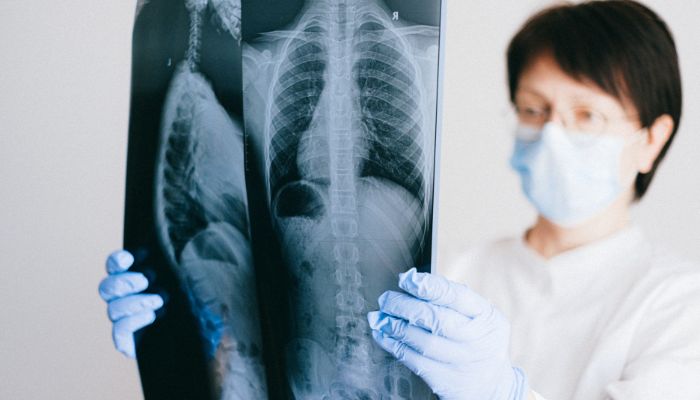|
A columnist describes one of the many ways the disease changed her life by Amy Gietzen As 2022 comes to an end, I’m reflecting on the year and trying to look forward to all 2023 might offer.
Many adults are probably excited to ring in the new year in style by going out on the town or enjoying a few drinks with friends. Sometimes I envy people who can spend a fortune on lavish outfits and expensive bottles of Champagne, and eat filet mignon and lobster tail in celebration. I long for the days when my only problem was deciding what to wear when I went out at night. The last time I went out for New Year’s Eve, I was 20 years old. At that point, I had recently been diagnosed with scleroderma and was in denial about my disease. So I behaved as if I were unaffected by symptoms, brushing aside the pain and discomfort and forcing my body to continue as normal. I made plans to go out with close friends to celebrate at a local bar. Sounds normal, right? Unfortunately, my evening was anything but normal. I ended up getting sick after one sip of my cocktail and had to leave immediately. I became sick several times on the drive home and had to pull over to vomit. I couldn’t understand what was wrong with me. In my mind, I was fine, when in reality, I was having a serious scleroderma flare-up. A dash of humor often helps me get the reaction I want from concerned others by Lisa Weber Scleroderma knows how to be a Debbie Downer. I can be enjoying a moment and BAM! Some debilitating pain or body malfunction pops up to ruin it.
I can’t control when I’ll need to hit the pause button on our fun, but I can control how I approach the situation so I don’t become the equivalent of the lights going out at a party. Having become a pro at living with pain and limitations, I’ve learned that if I share why I can’t do something, people understand. But they also show pity — which makes me feel even worse! I discovered that if I use colorful, silly descriptions to share the why behind my limitation, I cushion the negative impact it has on the company I’m with. Explanations require careful thought My husband and kids were so excited to be at the Tampa Bay Lightning hockey game. We walked endlessly around Amalie Arena looking for an elevator to take my broken lungs to the top floor. With the game about to start, I could see their excitement shifting to frustration. My youngest sighed and said, “Can’t we just take the stairs?” I know I should’ve taken a moment to explain how that could backfire, but I have a toxic trait: I think I can overcome any challenge. Without hesitation, I turned toward the stairwell and braced myself mentally for the battle ahead. My husband sounded the alarms and did his best to discourage me. But stubbornness is my other toxic trait. I made it up the first flight of 30 to 40 steps, but it didn’t feel good: burning lungs, pounding heart, shock waves of pain, as well as complete disorientation while my vision spun around and around. It was no surprise that I needed to take a break. Without question, my family huddled around me while I leaned against the wall in full concentration, practicing mind control so I wouldn’t panic. “Are you ready, Mom?” my teenage daughter asked, with anxiety in her voice. Here’s where I could’ve said, “I just need another minute.” But if I know teen girls, I’d probably get a quick eye roll. And if I shared the truth, “I just need a minute or I’m going to pass out,” I’d get those uncomfortable, concerned looks of worry. Celebrating Christmas has been complicated for columnist Amy Gietzen The holiday season is often a happy time. Giving gifts, spending time with family, and celebrating with food and conversation bring joy to many people. But for me, the holidays bring longing and envy.
Christmas has always been significant for my family. While we’ve always held parties on Christmas Eve, Christmas Day, and the following Saturday, we tend to celebrate throughout the entire month of December. Growing up, I really enjoyed this. What’s not to love about baking cookies, having gift-wrapping parties, and decorating the house inside and out? It wasn’t until I was diagnosed with scleroderma in 2001 that I started to find the holidays unenjoyable, exhausting, and lonely. Feeling like a Scrooge The first Christmas after my diagnosis was complicated. I knew nothing about scleroderma or what my future might entail. Everything was new and scary. That year, I decided not to share the details of my illness to avoid the pain of telling my loved ones that I was sick. So I zipped my lips and tried to fake my enjoyment of Christmas. By the next year, my entire family was aware that I had scleroderma. For the most part, they acted as if nothing had changed. No one asked me about my health or how I was coping, and I was thankful for that. I felt so awkward and uncomfortable in my skin that I was glad my family decided to avoid the topic. Unfortunately, I wasn’t so lucky moving forward. Every Christmas thereafter seemed to be worse. One year, a young relative asked me why my fingers were “broken” and if they hurt while we were all eating Christmas dinner. Another year, I was gifted a pair of gloves that didn’t fit because my fingers were so contracted. The final straw was when I contracted shingles on Christmas Eve. I ended up isolated in my room while my entire family gathered to exchange gifts and eat dinner. As the years ticked by, the season felt more and more different. Cousins grew up, married, and started their own Christmas traditions. Older uncles and aunts passed away. My siblings moved out and stopped spending so much time at home for the holidays. I know people change and grow, and families expand and evolve. But I began to feel lonely, cemented in place and stuck living a life where nothing changed. Scleroderma was constantly raining on my seasonal parade. Christmas had gone from being a joyous occasion to a holiday I couldn’t care less about celebrating. Study suggests periostin may be useful biomarker for systemic sclerosis by Lindsey Shapiro, PhD Blood levels of the periostin protein were associated with the degree of skin and cardiac involvement, but not lung or blood vessel involvement, in people with systemic sclerosis (SSc), a study found.
Levels of the protein also were higher in patients with diffuse forms of SSc, those living with the disease for a shorter time, and in male patients. Findings overall suggest that periostin may be a useful biomarker for predicting disease severity, particularly cardiac complications, in SSc. “To our knowledge, this is the first study to show that periostin is elevated in SSc cardiac tissue,” the researchers wrote, noting that “future work will need to prospectively investigate periostin levels in SSc patients.” The study, “Periostin overexpression in scleroderma cardiac tissue and its utility as a marker for disease complications,” was published in the journal Arthritis Research and Therapy. An anti-CCP antibody test may help with early detection of ILD by Margarida Maia, PhD People with systemic scleroderma (SSc) who test positive for cyclic citrullinated peptide (CCP) antibodies are more likely than those who test negative to develop interstitial lung disease (ILD) — when the lungs become scarred — and have worse lung function.
That’s according to data from a South Korean study that included people with systemic lupus erythematosus (SLE) or myositis, disorders with symptoms that sometimes overlap with scleroderma. The study, “A retrospective analysis of the relationship between anti-cyclic citrullinated peptide antibody and interstitial lung disease in systemic sclerosis,” was published in Scientific Reports. A CCP antibody test looks for anti-CCP antibodies in the blood. They are a type of autoantibody that wrongfully turns against healthy tissues in the joints. The levels of a small RNA molecule called microRNA-27a, or miR-27a, are significantly lower in the blood of women with systemic sclerosis (SSc) compared with healthy women, a study shows.Thus, “MiR-27a could serve as a reliable diagnostic marker for SSc,” researchers wrote, adding that the molecule “could be considered as a treatment option both for SSc and its related disorders and complications, which indeed necessitates further investigations.”
The study, “MiR-27a as a diagnostic biomarker and potential therapeutic target in systemic sclerosis,” was published in Scientific Reports. Many people have come and gone in the years I’ve been battling scleroderma. However, the friends and family members who stuck with me have taught me some valuable lessons about relationships, vulnerability, and strength. Before I was diagnosed with scleroderma in 2001, I was an extrovert, the life of the party, born to invoke cheer and fun. My schedule was jampacked with events, social outings, and gatherings with family, colleagues, and friends. Just before my diagnosis, all seemed right in the universe. At 19, my goals and dreams were starting to become a reality. Sometimes we push ourselves so hard we lose sight of what's important - By Lisa Weber All the bedroom doors were closed and everyone was tucked in under their warm comforters. Except for me. I had taken on the 2013 holiday season like it was another full-time job. Without enough daylight hours to squeeze it all in, I was working the graveyard shift and bleeding myself dry.
For a long time, I evaluated my value based on how much I could accomplish for myself and others. Acts of service, checked boxes on task lists … but there’s a trap to this method of pleasing people. I didn’t want to say no! I accepted every invitation. I committed to every cookie party, holiday light festival, and gift exchange. I didn’t want my kids to miss out, and I certainly didn’t want to let down friends and family. |
AuthorScleroderma Queensland Support Group Archives
July 2024
Categories
All
|
Scleroderma Association of Queensland
©Scleroderma Association of Queensland. All rights reserved. Website by Grey and Grey.








